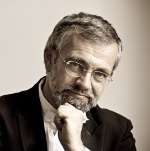Trivia question: How much attention did the 1906 Austrian premiere of Salome generate? Answer: Enormous. Apart from several heads of state, five famous composers – Gustav Mahler, Alexander von Zemlinsky, Arnold Schönberg, Alban Berg and Giacomo Puccini – made the pilgrimage to Graz. Also, the widow of Johann Strauss II, representing olde worlde charm, and the adolescent Adolf Hitler. The world was watching.
A level of heightened interest was almost tangible on the opening night of Opera Australia's Salome. Those who had not seen Gale Edwards’ 2012 staging (revived by Andy Morton), might also have been interested in how a female director would present obsessive, boundary-crossing female sexuality? (Curiously, English National Opera produced a new Salome five months ago, also directed by an female Australian director, Adena Jacobs)
Edwards’ direction is powerful and convincing. She and her inspired team created a stage, infiltrated with dark red hues (for blood has a major presence in this opera) in front of a nauseating display of giant carcasses on the back wall. In contrast, Salome in her white gown (changed later to black in the final scene) is followed by two strong spotlights throughout. The Dance of the Seven Veils – always a challenge to opera directors and not less so for sopranos, who are often asked to disrobe – is presented as a series of harrowing male fantasies: the pole dancer, the school girl, the scantily dressed nun, Marylin Monroe with her skirt blown upwards and so on. In another directorial change, Strauss’ page boy (sung transparently with appealing confidence by Sian Pendry) becomes here a caring young woman, with a premonition that something terrible is about to happen. She is right, of course, and in the final scene, the necrophiliac princess will caress and kiss and hold between her legs Jochanaan’s severed head. Since 2012, the shocking final seconds have been tamed: there is no gushing blood and the lights are out before the headsman would cut Salome’s throat.
However, some of Edwards’ directorial decisions are problematic. There are minor issues such as the strong light coming through from below the grille of Jochanaan’s underground cell, which contradicts the text referring to a dark dungeon. But more importantly, Jochanaan’s Old Testament authority becomes seriously undermined in his scene with Salome. Despite her later words to the contrary, he looks at her and touches her, as if, in fact, her sexual advances would be hard to resist.
Lise Lindstrom maintained the vocal and psychological arch in her gruelling role as the eponymous princess. Her voice is strong and has the requisite timbre required for such a difficult part, though her vibrato seemed to be too intense, particularly in the first half. Her stage persona made the sexually mature but emotionally impoverished, cunning but disdainful adolescent stepdaughter of Herod perfectly believable; she made her flirtatious dialogue with the defenceless Narraboth (Paul O’Neill) as frightening as her transgressive insistence to kiss the prophet.
Jochanaan’s movements are restricted by his chains and his unwavering condemnation of the sinful life that Herod lives and allows in his palace could make his part two-dimensional. Not on this night though, for Alexander Krasnov radiated a powerful stage presence and his resonant bass voice was awe-inspiring. His moral opposites are Herod and his wife, Herodias. In the latter role, Jacqueline Dark reprised her part from the 2012 production with malicious nastiness and in admirable vocal condition. Herod’s role is a more complex one. He respects Jochanaan and understands his preaching. Andreas Conrad’s singing, accurate and well characterised, made the tetrarch's delirious fears of winds, his lecherous longing for his stepdaughter and the reluctant order of beheading the prophet truly part of Herod’s personality.
Strauss' bickering Jews are here, somewhat confusingly, partly represented by other religions; for example a Greek Orthodox and perhaps a Catholic priest. All five singers took part in the religious hair-splitting with zest and pious commitment.
One of the protagonists of this opera is the orchestra. With Johannes Fritzsch at the helm, it delivered a solid rendition of this huge score. Fritzsch is one of the most dependable conductors residing in Australia, an outstanding expert of the late-Romantic operatic repertoire. He conducted with empathy and splendid technique. Perhaps it was his attention to maintain balance between stage and orchestra that did not allow the final scene to roar with the requisite boundless ecstasy. It is also true that the limited size of the Joan Sutherland Theatre orchestra pit limits the number who can perform there and, in particular, the string ensemble sounder thinner and less effective than what Strauss’ score would suggest.




